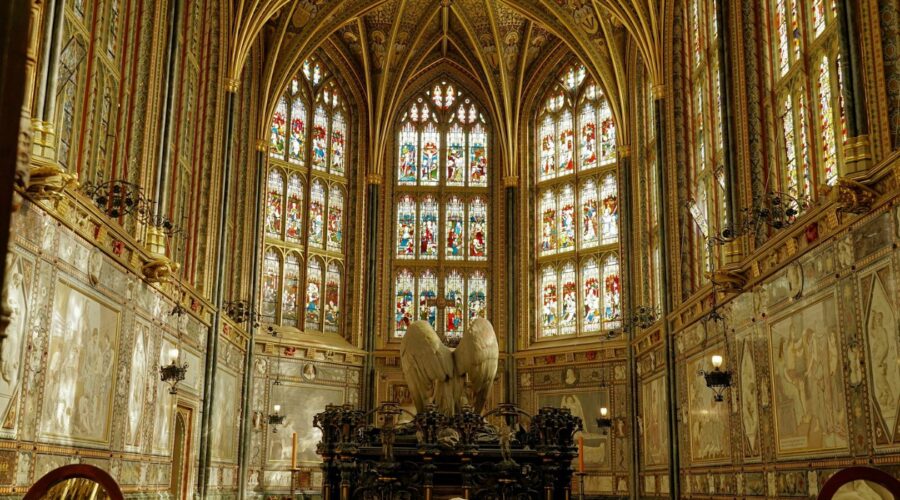Your cart is currently empty!
Unveiling the Majesty: A Comprehensive Exploration of Cathedrals

Introduction
Cathedrals stand as magnificent testaments to architectural brilliance, spiritual heritage, and cultural significance. These awe-inspiring structures have played a pivotal role in shaping cities, uniting communities, and preserving centuries-old traditions. This comprehensive guide delves into the captivating world of cathedrals, exploring their history, architecture, symbolism, and enduring impact.
History of Cathedrals
Origins in Early Christianity
The concept of cathedrals emerged in the 4th century when Christianity gained acceptance within the Roman Empire. Emperor Constantine I, recognizing the importance of a central place of worship for the growing Christian community, commissioned the construction of the Basilica of St. Peter in Rome. This basilica served as the model for many subsequent cathedrals.
Medieval Period: A Golden Age
The Middle Ages witnessed a surge in cathedral building across Europe. With the rise of powerful bishops, sophisticated building techniques, and an outpouring of religious fervor, cathedrals became symbols of civic pride and ecclesiastical authority. Gothic architecture, with its soaring spires, elaborate facades, and stained glass windows, became the defining style of medieval cathedrals.
Post-Reformation Era
The Reformation brought about significant changes to cathedral architecture. In Protestant-dominated regions, cathedrals often lost their religious significance and became secular buildings or were repurposed for other uses. In Catholic areas, cathedrals continued to thrive as centers of worship and ecclesiastical power.
Architectural Features of Cathedrals
Layout and Structure
Most cathedrals follow a cruciform layout, with a central nave flanked by aisles and transepts forming the arms of the cross. The nave, typically the widest part of the cathedral, leads towards the altar or sanctuary. The transepts provide additional space for seating and often feature side chapels.
Vaults and Arcades
Cathedrals are renowned for their impressive vaults and arcades. Vaults, supported by ribs or arches, distribute the weight of the roof and create an illusion of spaciousness. Arcades, consisting of a series of arches supported by columns, divide the nave from the aisles and create a sense of rhythm and harmony.
Stained Glass Windows
Stained glass windows are a defining feature of many cathedrals. These windows depict biblical scenes, saints, and other religious subjects. The vibrant colors and intricate designs not only enhance the beauty of the interior but also serve as a powerful means of religious education and storytelling.
Symbolism and Meaning in Cathedrals
Pilgrimage and Devotion
Cathedrals have long been destinations for pilgrims and devout Christians. They offer a sacred space for prayer, contemplation, and connection with the divine. Relics of saints and other religious artifacts are often housed within cathedrals, attracting pilgrims seeking blessings and spiritual guidance.
Ecclesiastical Power and Prestige
Cathedrals symbolize the power and prestige of the Church. They serve as the seats of bishops or archbishops and are often the largest and most elaborate buildings in a diocese. The grandeur of cathedrals reflects the authority and influence of the Church and its role in society.
Architectural Triumphs
Cathedrals are not only religious structures but also architectural masterpieces. They showcase the ingenuity and artistry of medieval builders and stand as testaments to human creativity and ambition. The intricate carvings, soaring spires, and vast interiors evoke a sense of awe and wonder in visitors.
Impact of Cathedrals
Civic and Cultural Hubs
Cathedrals have historically been central to the life of cities. They serve as venues for civic events, concerts, and exhibitions. Their presence often attracts tourists, stimulates economic activity, and enriches the cultural fabric of the community.
Preservation of History
Cathedrals are repositories of history and art. They contain priceless artifacts, manuscripts, and relics that provide insights into past civilizations and the development of Christian liturgy. By preserving these cultural treasures, cathedrals play a vital role in protecting the collective memory of communities.
Education and Community
Cathedrals have traditionally served as centers of learning and education. In the Middle Ages, cathedral schools played a crucial role in spreading knowledge and培养scholars. Today, many cathedrals offer educational programs, lectures, and workshops that engage with the community and foster spiritual growth.
Types of Cathedrals
Western Cathedrals
Western cathedrals are characterized by the Gothic and Romanesque architectural styles. They have elaborate vaulted ceilings, pointed arches, and extensive use of stained glass windows. Some notable examples include Notre Dame Cathedral in Paris, Westminster Abbey in London, and Cologne Cathedral in Germany.
Eastern Cathedrals
Eastern cathedrals, primarily found in Orthodox Christian countries, follow a Byzantine style of architecture. They have a central dome, a semicircular apse, and a richly decorated interior. Some famous Eastern cathedrals include the Hagia Sophia in Istanbul, the Cathedral of Christ the Savior in Moscow, and the Church of the Holy Sepulchre in Jerusalem.
Conclusion
Cathedrals are architectural marvels that embody the confluence of religion, art, and history. Their majestic presence continues to inspire awe and wonder in people from all walks of life. From their humble origins in early Christianity to their enduring significance in modern times, cathedrals have played an integral role in shaping civilizations and enriching human experience.
Whether it’s for religious devotion, architectural appreciation, or historical exploration, cathedrals invite us to transcend time and connect with the spiritual and cultural heritage that defines our world.